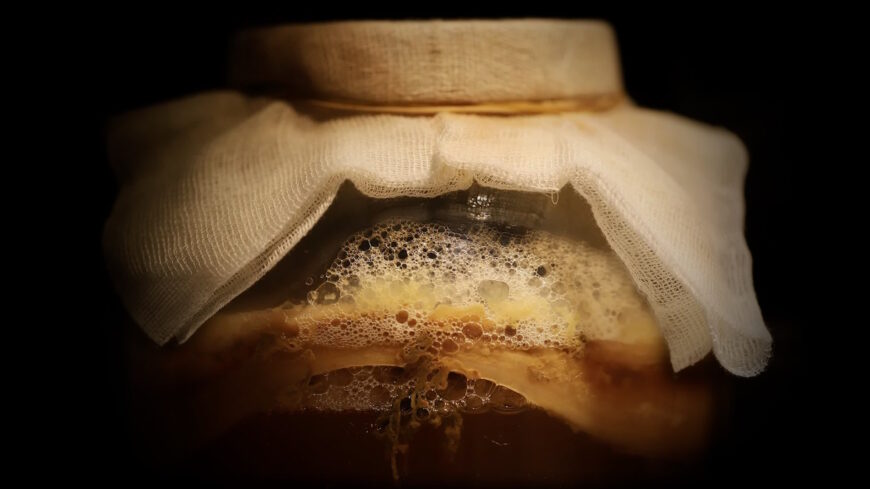
The Health Benefits of Fermented Kombucha Beverage
by Sally Fallon Morell, Weston A. Price Foundation
May 21, 2024
This recipe is from the “Beverages” section of Nourishing Traditions and can be found on page 496. It reflects the fifth of our 11 Wise Traditions Dietary Principles: enjoy lacto-fermented condiments and beverages.
It seems surprising, even ironic, to conclude a health food cookbook, in which we have warned against sugar, yeasted foods and tea, with a tonic made from sugar, yeast and tea! But the kombucha “mushroom” (which is actually a symbiotic colony of yeast and bacteria) acts on sugar and tea to produce not only acetic and lactic acid but also small amounts of a potent detoxifying substance, glucuronic acid. Normally this organic acid is produced by the liver in sufficient quantities to neutralize toxins in the body— whether these are naturally produced toxins or poisons ingested in food and water. However, when liver function becomes overloaded, and when the body must deal with a superabundance of toxins from the environment—certainly the case with most of us today—additional glucuronic acid taken in the form of kombucha is said to be a powerful aid to the body’s natural cleansing process, a boost to the immune system and a proven prophylactic against cancer and other degenerative diseases.
More importantly, kombucha is the cure for a hot day—it tastes delicious and refreshing. A fizzy, dark colored, energizing beverage, at the same time acidic and slightly sweet, this gift to the world from the Ural mountain region of Russia qualifies as the soft drink of the twenty-first century, the answer to the scourge of cola drinks that now wreaks havoc with the health of Western populations.
Read the article: In a world full of soda, be a kombucha. for more background!
The following recipe makes 2 quarts:
INGREDIENTS
- 3 quarts filtered water
- 1 cup sugar [organic cane sugar]
- 4 tea bags of organic black tea
- ½ cup kombucha from a previous culture
- 1 kombucha mushroom
INSTRUCTIONS
- Bring 3 quarts filtered water to boil.
- Add sugar and simmer until dissolved.
- Remove from heat, add the tea bags and allow the tea to steep until water has completely cooled.
- Remove tea bags. Pour cooled liquid into a 4-quart pyrex bowl and add ½ cup kombucha from previous batch.
- Place the mushroom on top of the liquid.
- Make a crisscross over the bowl with masking tape, cover loosely with a cloth or towel and transfer to a warm, dark place, away from contaminants and insects. [Alternatively, put a loose cloth over the container and tie it in place so it dosen’t fall in!]
- In about 7 to 10 days the kombucha will be ready, depending on the temperature.
- It should be rather sour and possibly fizzy, with no taste of tea remaining.
- Transfer to covered glass containers and store in the refrigerator. (Note: Do not wash kombucha bowls in the dishwasher.)
- When the kombucha is ready, your mushroom will have grown a second spongy pancake. This can be used to make other batches or given away to friends.
- Store fresh mushrooms in the refrigerator in a glass container—never plastic. A kombucha mushroom can be used dozens of times. If it begins to turn black, or if the resulting kombucha doesn’t sour properly, it’s a sign that the culture has become contaminated. When this happens, it’s best to throw away all your mushrooms and order a new clean one.
- Note: White sugar, rather than honey or Rapadura, and black tea, rather than flavored teas, give the highest amounts of glucuronic acid. Non-organic tea is high in fluoride so always use organic tea.
- A word of caution: Some individuals may have an allergic reaction to kombucha. If you have allergies, start with a small taste to observe any adverse effects. If you react badly, use beet kvass several weeks to detoxify and then try again.
Connect with Weston A. Price Foundation
Cover image credit: Nennieinszweidrei

Truth Comes to Light highlights writers and video creators who ask the difficult questions while sharing their unique insights and visions.
Everything posted on this site is done in the spirit of conversation. Please do your own research and trust yourself when reading and giving consideration to anything that appears here or anywhere else.










